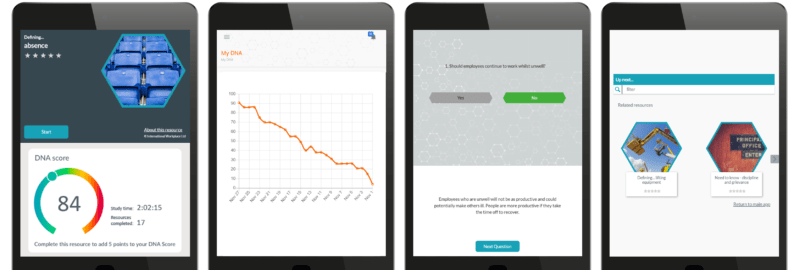John Kersey looks at International Workplace’s recently launched FM and HR orientated microlearning package Workplace DNA and meets its Founder, David Sharp.

Microlearning is becoming a hot topic in the world of learning and development which taps into a number of key trends. There is an increasing feeling that trainees need to own their learning and competence provision. Also, with a busy workstyle there is less time and opportunity for formal classroom or even full e-learning courses. Sometimes competent learners just need some refresher training where they may feel rusty on a topic or need to get up to date on a less practised subject.
Workplace DNA offers a range of modules streamed into four categories covering risk, people and culture, workplace and facilities. The modules are short, about five minutes or less, mobile friendly and presently cover about 400+ topics in those domains. So what determines the subject areas covered? Basically it is influenced by the mindmap, ‘What FMs Do‘, formulated by Martin Pickard of FM Guru. This is a starting point and covers many areas of general interest to other professionals such as health and safety practitioners.
The unique part of the system is a DNA score – basically learners are allocated a Pathway or a curriculum from the chosen modules. This helps keep the learner focussed on the desired courses which is reflected in their DNA score. Different Pathways can be allocated to different roles, teams or specialisms. The learner is encouraged to maintain their score (and hence their learning) through consumption of learning resources. The package uses AI to identify suitable courses and content and the reward to them is an enhanced DNA score. To further motivate learners the score can be used competitively through gameification and devices such as leaderboards. To further provide motivation and maintenance of learning there is a monthly DNA test of ten questions informed by the AI behind the system. The results are reflected in the learners ongoing DNA score. Using a common basis as a metric for learning helps internal management analytics as well as external benchmarking and even transfer of employees between employers where Workplace DNA is a common system.

David Sharp, Founder of International Workplace talks about Workplace DNA and the thinking behind it.
Can you tell us something about yourself? How did you get involved in delivering learning solutions?
 David Sharp (DS): “I started my career in publishing, researching ideas and commissioning authors for reference manuals and business books, ultimately running the Financial Times booklist for Pearson. In 1995 I set up what is now International Workplace, publishing practical and legal information for the facilities management sector. I’ve always been interested in innovative ways of helping people and employers develop their competence, and so our focus naturally moved from publishing to training. I’ve made a conscious effort to always study the courses that we’ve delivered to our clients myself, so have experienced first-hand what’s involved in delivering and studying for a CIPD or NEBOSH qualification.”
David Sharp (DS): “I started my career in publishing, researching ideas and commissioning authors for reference manuals and business books, ultimately running the Financial Times booklist for Pearson. In 1995 I set up what is now International Workplace, publishing practical and legal information for the facilities management sector. I’ve always been interested in innovative ways of helping people and employers develop their competence, and so our focus naturally moved from publishing to training. I’ve made a conscious effort to always study the courses that we’ve delivered to our clients myself, so have experienced first-hand what’s involved in delivering and studying for a CIPD or NEBOSH qualification.”
What prompted both you and your team to explore a microlearning solution that evolved into Workplace DNA?
(DS): “We realised in 2015 that we needed to know a lot more if we were going to move away from simply turning classroom courses into eLearning. There were three significant gaps in our knowledge. We wanted to understand more about the new technologies that were revolutionising every aspect of our daily lives. We wanted to gain insight into the way people learn. And we wanted to get a better understanding of the issues that our clients and our learners were facing. This led us to become a signatory of the Serious eLearning Manifesto and to explore the effectiveness of spaced repetition, and to adopt a microlearning approach for our learning resources.”
From the launch event I detected a couple of key influences – the works of Dr Itiel Dror and Andy Lancaster (author of “Driving performance through learning”). What are your personal insights from these?
(DS): “Dr Dror’s work on how the brain learns has been very instructive. Itiel and Andy provide some excellent insights for learners, employers and developers of learning solutions like us. Both experts value outcomes over inputs: the focus is on the learner and what they’ve learned, as opposed to the trainer and how they’ve delivered it. Both emphasise the importance of knowledge retention, not just acquisition. Both are concerned with planned learning becoming unobtrusive and easy for the learner – reducing what Dr Dror refers to as ‘cognitive load’, and delivering what Andy refers to as ‘learning in the flow of work’. Andy is particularly strong on the need to link learning outcomes to organisational performance.”
How did you identify the particular “bite-sized” modules needed for Workplace DNA?
(DS): “Since starting the company with a newsletter called Facilities Management Legal Update nearly 25 years ago, we’ve always focused on a wide range of subject matter including health, safety and wellbeing, sustainability and environmental management, employment law and human resources, as well as softer skills such as leadership, customer service and cultural awareness. In bringing this into a formal curriculum for Workplace DNA, our starting point was the globally acclaimed mindmap produced by Martin Pickard at FM Guru, which covers over 200 different workplace-related tasks and disciplines.”
One of the USPs for the package is the DNA score – how do you see that being applied?
(DS): “Traditionally, a learner’s score will relate to their performance on a course and will be fixed in time. There are no courses in Workplace DNA and the DNA score is totally different. A learner’s DNA score is designed to be a measure of engagement, and because the ecosystem delivers continuous learning in small pulses throughout the year, it measures engagement over time. So if the learner fails to engage with the curriculum, their DNA score will degrade. Employers are able to display DNA scores on a leaderboard if they wish to and can use them as an objective measure as part of a performance appraisal.
How do you see the package developing? Will it evolve with initiatives such as the IOSH Competency Framework?
(DS): “The service will never stand still, that’s for sure. In terms of content, we want to focus on depth rather than breadth. Ensuring that the content maps against recognised standards (what we refer to as ‘credentialling’) is very important. Since the launch we have agreed with the Royal Institute of Chartered Surveyors (RICS) to map against their standards, and we are engaging with IOSH about its Competency Framework. We also need to be mindful of the responsibilities that come with curation – the effort required for content maintenance, as well as development.
“The biggest benefits are likely to be felt from machine learning however, as the underlying data model becomes more sophisticated in delivering personalised learning for every individual.”
How do you see technology in general being applied to learning over the next five years?
(DS): “Learning is one of the few areas that hasn’t fully embraced the power of AI until now. We see a step-change here. AI will play a greater role in helping to make learning easier and less obtrusive for the learner, by cutting down on admin and putting the right sort of content in front of people when they need it.
“Looking slightly further ahead, a more advanced use of AI will be to auto-update and/or auto-compile content without the need for human authoring, so that the learning system becomes autonomous.
“We’re also beginning to see some interesting applications of virtual reality (VR) and augmented reality (AR) technologies, with the latter something we’re considering for the Workplace DNA resource library.
“Technology Enhanced Learning: The good, the bad, and the ugly.” Itiel E. Dror. Pragmatics & Cognition, 16:2 (2008) p.215-223
Disclaimer. The views expressed in this article are those of the author and do not necessarily represent those of any commercial, academic or professional institution I am associated with. Mention of a specific product or service does not necessarily equal endorsement.
Advance your career in health and safety
Browse hundreds of jobs in health and safety, brought to you by SHP4Jobs, and take your next steps as a consultant, health and safety officer, environmental advisor, health and wellbeing manager and more.
Or, if you’re a recruiter, post jobs and use our database to discover the most qualified candidates.



 David Sharp (DS): “I started my career in publishing, researching ideas and commissioning authors for reference manuals and business books, ultimately running the Financial Times booklist for Pearson. In 1995 I set up what is now International Workplace, publishing practical and legal information for the facilities management sector. I’ve always been interested in innovative ways of helping people and employers develop their competence, and so our focus naturally moved from publishing to training. I’ve made a conscious effort to always study the courses that we’ve delivered to our clients myself, so have experienced first-hand what’s involved in delivering and studying for a CIPD or
David Sharp (DS): “I started my career in publishing, researching ideas and commissioning authors for reference manuals and business books, ultimately running the Financial Times booklist for Pearson. In 1995 I set up what is now International Workplace, publishing practical and legal information for the facilities management sector. I’ve always been interested in innovative ways of helping people and employers develop their competence, and so our focus naturally moved from publishing to training. I’ve made a conscious effort to always study the courses that we’ve delivered to our clients myself, so have experienced first-hand what’s involved in delivering and studying for a CIPD or